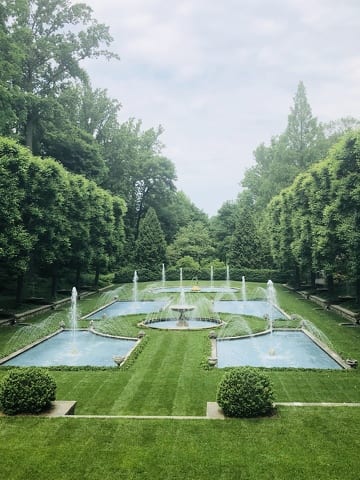“When weeding, the best way to make sure you are removing a weed and not a valuable plant is to pull on it. If it comes out of the ground easily, it is a valuable plant.”
— Author unknown
Turfgrass and weeding of turfgrass (and elsewhere) often go hand-in-hand, so it seemed appropriate to combine them in one discussion.
One of my favorite nephews manages a golf course in the south. When he was getting a ribbing for being a “golf” major at Penn State, few of us family members realized how comprehensive the golf management turfgrass program was at that time. An alphabetical listing of courses today starts with agricultural systems management, includes everything from botany, entomology, as well as plant pathology, and ends with ten offerings of turfgrass classes. Golf course managers certainly have a broad knowledge of turfgrass from A to Z.
It’s a specialized art and, believe it or not, helped pave the way for lawn pride in general.
There are benefits to having turfgrass on any property. It adds color, a cooling effect around buildings, provides coherence to pull together different parts of the landscape, and stabilizes soil to avoid erosion. It also adds aesthetic value.
So, how did Americans develop their love of homegrown manicured lawns?
Strangely, according to a 2019 article in the New York Times, most turfgrass actually is not native to the United States. In the 1600s Europeans colonizing America brought farm animals that consumed local grasses. This meant that the colonists were forced to import foreign seeds to grow new grass for their animals (believe it or not, Kentucky Bluegrass is actually native to places like Europe and Africa).
After the American Revolution, wealthy men like George Washington and Thomas Jefferson helped to popularize the great lawns of European landscape architecture by including something similar in their own estates.
Fast forward to the 1800s, when an engineer in southwest England got an idea and filed a patent for the first lawn mower. This was in 1830 — the idea came here 40 years later.
Right about that time a book called “The Art of Beautifying Suburban Home Grounds” became very popular and equated a perfect lawn with being a model citizen. Other inventions of tools like sprinklers and hoses, as well as other necessary lawn equipment followed over the years, along with colorful advertisements to entice buyers.
Further enticements were the 1887 US Department of Agriculture grass displays at Philadelphia’s Centennial Exhibition and the encouragement to start a lawn when New York became home to America’s first golf course.
In 1914 the Times profiled President Teddy Roosevelt having just mowed his lawn as a diversion to politics. Having a beautiful lawn gradually became equated with achieving the American dream.
With climate concerns today Americans have begun to question whether pursuing the perfect expansive lawn has led to excessive use of pesticides on their grass, as well as creating emissions and noise pollution from gas lawn mowers and other power equipment. Many people have chosen to reduce the size of their lawns to create more biodiversity with options like pollinator gardens, for example. This remains a personal choice.
Of less of a personal choice are the weeds we all find in our yards, both in the turfgrass and everywhere.
What is a weed? It’s hard to pin down an exact definition. Some suggest that there are no weeds, but that argument is still being refined.
On reflection, a definition that works for me is that it’s an unloved plant (for that time and place). Weeds are opportunistic, growing where soil has been disturbed or where they’ve been dropped by birds or mammals and crowd out desirable plants, spreading unchecked. A good example is Dame’s rocket, the beautiful lavender and white drifts we’ve seen lately alongside roads. However, this is not native Phlox paniculata, it is Hesperis matronalis. Dame’s rocket can be invasive and has displaced many native plants as it has moved across the country. It is not what is best planted in home gardens.
Cases like this show that it is good to know exactly what the Latin names of the weeds are that are wreaking havoc. And Apps like iNaturalist can identify a plant from a phone picture.
Another great resource is “Weeds of the Northeast” a book by Richard H. Uva, Joseph C. Neal and Joseph M. DiTomaso. It gives directions on identifying a weed based on observed characteristics and offers complete information and pictures of each weed. A third way is by accessing the Weed Science Society of America’s master list of weed databases.
Knowing the identification of a weed helps to learn its life cycle (when it flowers and sets seeds in order to pull or mow it down before that), and whether it spreads with surface runners, called stolons (like creeping Charlie) or by rhizomes or underground stem tissue that has buds (like wild morning glory). A plant with stolons is easier to pull; a weed with rhizomes needs to be carefully dug out to get the entire root.
The best advice for organic weed eradication is to start early, while the weed is a seedling, and act quickly to pull it out again and again. (I let them get a little larger just so they are easier to remove).
Extension services can offer more guidance for specific weedy circumstances.
Using home remedies or other chemical controls is not encouraged, from what I’ve seen.
Interested in knowing the most noxious weeds in Pennsylvania, according to the USDA? Their common names are musk, nodding, Canadian, bull and spear thistle, jimsonweed, goatsrue, giant hogweed, purple loosestrife, mile-a-minute, kudzu-vine, multiflora rose, shattercane and johnsongrass.
Knowing your weed enemy and going in for eradication early and often seems the key to helping garden areas (including turfgrass) have manageable weed populations.



